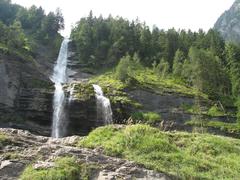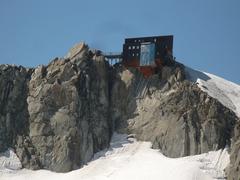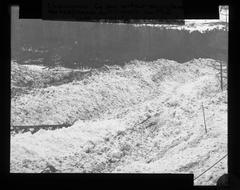
Mont Dolent Visiting Hours, Tickets, and Guide from Chamonix-Mont-Blanc
Date: 03/07/2025
Introduction
Mont Dolent, with its striking pyramidal summit at 3,823 meters (12,543 feet), is a unique alpine peak where France, Italy, and Switzerland converge within the Mont Blanc Massif. Renowned for its dramatic landscapes, historical significance, and challenging ascent routes, it draws mountaineers, hikers, and travelers interested in both natural splendor and European heritage. This comprehensive guide provides essential information on visiting hours, tickets, access, safety, and cultural context for those approaching Mont Dolent from Chamonix-Mont-Blanc and beyond. Whether you are a climber, trekker, or cultural explorer, Mont Dolent offers an unforgettable alpine experience. For in-depth route details and local insights, consult resources such as the Chamonix Mountain Guide, Compagnie des Guides de Chamonix, and the official Chamonix tourism site.
Table of Contents
- Discover Mont Dolent: A Unique Alpine Destination
- Historical Overview of Mont Dolent
- Visitor Information: Tickets, Visiting Hours, and Travel Tips
- Cultural Significance
- Mont Dolent Routes and Access
- Seasonal and Weather Considerations
- Logistics and Safety
- Environmental Challenges and Conservation
- Accommodation and Mountain Huts
- Climbing and Hiking Routes
- Equipment and Safety
- Health, Safety, and Emergency Services
- Special Events and Notable Spots
- Practical Tips
- FAQ
- References
Discover Mont Dolent: A Unique Alpine Destination
Mont Dolent rises where France, Italy, and Switzerland meet, offering a blend of natural beauty, rich history, and international symbolism. The mountain’s iconic pyramid shape, prominent glaciers, and tripoint boundary marker make it a coveted goal for climbers as well as a landmark for hikers on the Tour du Mont Blanc. In this guide, you’ll find all the essential visitor advice, from hours and ticketing to routes and safety, alongside the mountain’s historical and cultural significance.
Historical Overview
Geopolitical and Borderland Heritage
Mont Dolent serves as a precise tripoint where national borders meet, marked by centuries-old boundary stones and engraved toponyms (LoveVDA, Histoire de Bornes). The region’s boundaries have shifted over millennia, from ancient Celtic tribes to medieval abbeys, and later through Savoy, Valais, and France. Visitors can find historic markers adorned with Savoy crosses and Valais coats of arms, offering a tangible link to the area’s geopolitical past.
Mountaineering and Exploration
Mont Dolent’s steep faces and four ridges have long attracted mountaineers. The mountain’s first ascent in 1864, by A. Reilly, E. Whymper, M. Croz, and M. Payot, was a landmark achievement in the golden era of alpinism. Its proximity to Chamonix—a cradle of modern mountaineering—ties Mont Dolent to the legacies of the first Mont Blanc ascent and the founding of the Compagnie des Guides de Chamonix (Chamonix All Year, Chamonix.net).
Natural and Environmental History
Mont Dolent influences several glaciers, including the Pré de Bar, Argentière, Dolent, and A Neuve. Research on glacial change and moraines in the area reveals the ongoing impact of climate change (ResearchGate). Educational trails and interpretive programs in the Chamonix Valley highlight the region’s delicate ecosystem and changing climate (Autour du Mont-Blanc).
Visitor Information: Tickets, Visiting Hours, and Travel Tips
Visiting Hours and Access
Mont Dolent itself is a natural summit with no fixed visiting hours. Trailheads and regional visitor centers in Chamonix, Courmayeur, and Val Ferret are open year-round, with seasonal variations in hours.
Tickets and Guided Tours
Access to the mountain and its base areas is free. However, reservations and payment are required for guided ascents and overnight stays at mountain huts, such as Refuge d’Argentière (France), Cabane de l’A Neuve (Switzerland), and Bivacco Fiorio (Italy).
How to Get There
- From Chamonix (France): Access via Argentière or Le Tour, by car, train, or local shuttle.
- From Courmayeur (Italy): Reachable by road, with access to the southern approach.
- From Val Ferret (Switzerland): Access via La Fouly, with seasonal bus service.
Best Time to Visit
The optimal season is late June to early September, when weather conditions are favorable and huts are open. Winter visits require technical experience and equipment.
Accessibility
While the summit is suitable only for experienced alpinists, the surrounding valleys and villages (e.g., Chamonix, La Fouly) are accessible to families and casual visitors.
Nearby Attractions
Explore Chamonix’s historical sites, museums, and local festivals, or hike the Tour du Mont Blanc for panoramic views of Mont Dolent and the massif (Chamonix Valley Travel Guide).
Cultural Significance
Symbol of International Cooperation
The summit’s tripoint boundary marker is a symbol of peaceful coexistence and collaboration between France, Italy, and Switzerland (Histoire de Bornes).
Alpine Traditions and Local Identity
Communities in the region celebrate shared alpine heritage through crafts, cuisine, and festivals (Chamonix.com).
Artistic and Educational Initiatives
Mont Dolent’s landscapes have inspired artists and poets. Interpretive trails and exhibitions foster awareness of ecology and mountaineering history (Autour du Mont-Blanc).
Mont Dolent Routes and Access
Overview
Mont Dolent can be approached from three countries, each offering distinct routes:
| Route | Starting Point | Hut/Bivouac | Grade | Summit Day Time | Notes |
|---|---|---|---|---|---|
| French (Argentière) | Argentière | Refuge d’Argentière | D | 6–8 hrs | Glacier navigation, remote atmosphere |
| Swiss (La Fouly) | La Fouly | Cabane de l’A Neuve/Bivouac | AD | 3–4 hrs | Classic east ridge, exposed mixed terrain |
| Italian (Arnouva) | Arnouva (Val Ferret) | Bivacco Fiorio | PD | 4 hrs | Direct glacier route, exposed ridge |
French Approach: Chamonix–Argentière
- Trailhead: Argentière; base at Refuge d’Argentière (2,771 m).
- Route: Glacier d’Argentière, Col du Tour Noir or Col du Chardonnet, complex glacier navigation.
- Difficulty: Demanding; technical gear required.
Swiss Approach: Val Ferret–La Fouly
- Trailhead: La Fouly; base at Cabane de l’A Neuve (2,735 m).
- Route: Glacier de l’A Neuve, Col de l’Argentine, east ridge ascent.
- Difficulty: Mixed snow and rock, classic AD route.
Italian Approach: Val Ferret–Arnouva
- Trailhead: Arnouva; base at Bivacco Fiorio (2,724 m).
- Route: Glacier de Pré de Bar, southeast ridge.
- Difficulty: PD grade; glacier travel with exposed sections.
Viewing Mont Dolent for Non-Climbers
Hikers on the Tour du Mont Blanc trail near La Fouly enjoy excellent views of Mont Dolent. Chamonix and Courmayeur also offer scenic viewpoints, cultural sites, and accessible trails.
Seasonal and Weather Considerations
- Best Season: Late June to early September.
- Weather: Highly variable; sudden storms and temperature drops are common.
- Avalanche/Glacier Hazards: Present outside the main season; always check local bulletins.
Logistics and Safety
- Guided Tours: Strongly recommended for non-experts; available in all three countries (Chamonix Guides).
- Equipment: Alpine gear—including crampons, ice axe, rope, helmet, harness, and crevasse rescue kit—is essential.
- Navigation: Use IGN, Swisstopo, or IGC maps, plus GPS.
- Connectivity: Mobile coverage is limited; consider a satellite device.
- Emergency: Dial 112 for mountain rescue.
Environmental Challenges and Conservation
Mont Dolent’s glaciers and terrain are sensitive to climate change, with glacial retreat and permafrost thaw impacting climbing routes. Conservation efforts include waste management, bivouac restrictions, and public awareness campaigns (en.chamonix.com).
Accommodation and Mountain Huts
Chamonix and Surroundings
Chamonix provides a wide array of accommodations, from luxury hotels to hostels (Chamonix info). Advance booking is highly recommended in the summer.
Mountain Huts
- Refuge d’Argentière (2,771 m, France): Staffed in summer; book via SAC Tourenportal.
- Cabane de l’A Neuve (2,735 m, Switzerland): Common base for the northeast ridge.
- Bivacco Cesare Fiorio (2,725 m, Italy): For the Italian approach; unstaffed, bring all supplies.
Reservations are essential in high season.
Climbing and Hiking Routes
- Summit Route: The classic northeast ridge from Switzerland is PD+ (Peu Difficile Plus) and involves glacier and mixed climbing.
- Hiking: Tour du Mont Blanc and Val Ferret trails offer rewarding views for non-climbers (Mountain Field Guide).
Equipment and Safety
- Gear: Mountaineering boots, crampons, ice axe, harness, rope, helmet, weatherproof clothing, navigation tools, and emergency kit.
- Guides: Hire certified guides if you lack technical alpine experience (Compagnie des Guides de Chamonix).
- Insurance: Ensure coverage for mountain rescue and technical climbing.
Health, Safety, and Emergency Services
- Altitude: Acclimatize to minimize risk of altitude sickness.
- Rescue: Dial 112 for emergencies.
- Insurance: Confirm your travel policy covers alpine activities.
Special Events and Notable Spots
- Photography: Sunrise/sunset from Val Ferret or Tour du Mont Blanc offers stunning perspectives.
- Cultural Visits: Alpine Museum and historical sites in Chamonix (Chamonix Historical Sites).
Practical Tips
- Book huts and guides ahead for summer visits.
- Carry cash; some huts do not accept cards.
- Dress in layers; conditions change rapidly.
- Begin summit days early to avoid afternoon storms.
- Respect quiet hours and local customs.
- Sample regional dishes in Chamonix and nearby villages.
Frequently Asked Questions (FAQ)
Q: Do I need tickets to visit or climb Mont Dolent?
A: No tickets are needed for the mountain itself, but mountain hut stays require reservations.
Q: When is the best time to climb Mont Dolent?
A: Late June to early September.
Q: Can beginners hike Mont Dolent?
A: The summit is for experienced alpinists; beginners can enjoy local trails and views.
Q: Are guided tours available?
A: Yes, local companies offer a range of guided ascents and treks.
Q: Is it necessary to book huts in advance?
A: Yes, especially in peak season.
Q: What should I bring for a hut stay?
A: Sleeping bag liner, headlamp, personal items, and cash.
Visual and Interactive Media
References and Official Links
- LoveVDA - Mont Dolent
- Chamonix Mountain Guide
- SAC Route Portal
- The Tourist Checklist – Mont Blanc Mountain
- Chamonix.net Official Mountaineering Guide
- Mountain Field Guide – Mont Dolent
- Autour du Mont-Blanc: Natural and Cultural Heritage
- Histoire de Bornes: History of the Border
- Chamonix.com: Heritage, Education and Culture
- Chamonix-Mont-Blanc Valley Official Site
Internal Links
Summary and Visitor Tips
Mont Dolent stands as a symbol of alpine beauty, cultural exchange, and environmental stewardship. Its summit, accessible from three countries, challenges experienced climbers, while its surrounding valleys and trails welcome hikers and cultural visitors. Proper preparation, guide services, and respect for environmental regulations are crucial for a safe adventure. Use digital tools like the Audiala app for up-to-date info, and take time to explore Chamonix’s rich history. Embrace the spirit of adventure and preservation for an inspiring Mont Dolent experience.
For live updates, route maps, and community insights, download the Audiala app and follow us on social media.




